|
Exercise 5: Various Visual Illusion
What you see is not always what is there. Or is it? The eye can play tricks on the brain. Here are several illusions that demonstrate this point.
- The Magic Cube
Look at the center cube. What side is the front? Is the front as shown on the cube on the right side or is the front as shown on the cube on the left side or is there no front at all?

- Which of the lines shown below is longer?
Muller-Lyer Illusion

Measure them. You may be surprised to find out that they are the same length. We see the lines as different because we have been "taught" to use specific shapes and angles to tell us about size.
- Stare at the middle of picture with black squares 15-30 seconds. Are those really dots that appear at the corners of the squares? What happens if you focus on a dot? Now look at the middle of the picture with the white squares. Do you see dots again? What color are they?
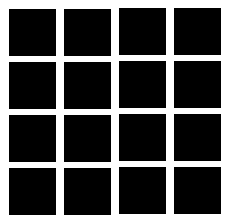  
Here is another example of the same illusion.
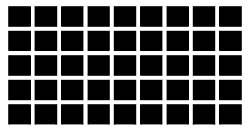  
Are the locations of the spots different in these two pictures? Why?
- Do you see a vase or a face in the figure below? This type of picture was first illustrated by psychologist Edgar Rubin in 1915. Notice that it is very difficult to see both the faces and the vase at the same time. This may happen because we tend to focus our attention on only one part of the image...either the faces or the vase.
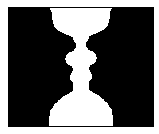
- Afterimages
Stare at the yellow + in the middle of figure for 15-30 seconds. Then move your gaze off to the white square on the right. Did the colors really reverse themselves? This is an example of an "afterimage".
  
- Here's another example of creating an afterimage. Can you put the fish in the bowl? Try this. Stare at the yellow stripe in the middle of the fish in the picture below for about 15-30 sec. Then move your gaze to the fish bowl. You should see a fish of a different color in the bowl. It helps if you keep your head still and blink once or twice after you move your eyes to the bowl. The afterimage will last about five seconds.

What's Happening: in the retina of your eyes, there are three types of color receptors (cones) that are most sensitive to either red, blue or green. When you stare at a particular color for too long, these receptors get "tired" or "fatigued." When you then look a different background, the receptors that are tired do not work as well. Therefore, the information from all of the different color receptors is not in balance. Therefore, you see the color "afterimages."
Stare at the + for about 15 seconds, then shift your gaze to the right side of the image.
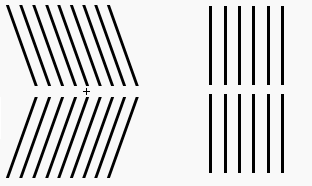 |
Stare at the + for about 15 seconds, then shift your gaze to the right side of the image.
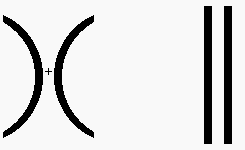 |
| Do the lines on the right side of the image look straight? Are they really straight? |
7. The Poggendorff Illusion was created by Johann Poggendorff in 1860. Are the lines behind the rectangles straight or not? It looks as if it does not go straight across, but does it?
Poggendorff Illusion

8. Hmmm...is the center circle on the right the same size as the center circle on the left? For many people it appears that the circle that is surrounded by the small circles is larger that the circle that is surrounded by the larger circles. However, I know that they are the same size....I copied and pasted the same exact circle into the middles!!
Titchener Illusion

This illusion shows that our brains judge size by comparing objects to things in the surroundings.
9. The Wundt Illusion. Which arc is larger? You might see that the top one is smaller, but they are the same size. The top one looks smaller because the shorter arc of the top figure is next to the large arc of the bottom figure.

|
10. Is this book opening toward you or away from you?

|
11. To tee or not to tee...that is the question. This inverted "T" has two lines....are they the same length? You bet they are. Measure them yourself.
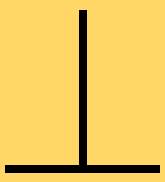
|
12. Which arc comes from the circle with the largest diameter?

It probably looks like arc C is part of the largest circle. However, all the arcs are actually from the SAME circle. Look at the same figure again - however, this time the right and left sides of the larger two arcs are blocked. Each arc comes from a circle of identical size.

|
| 13. Subjective Contours: Filling the gap. Your brain tries to fill in these four pictures with images that really are not there. Do you see a:
Cube?
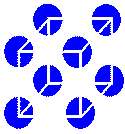 |
Triangle?
 |
Square?
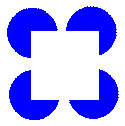 |
Rectangle?
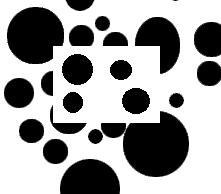 |
 |
|
14. Baldwin Effect: The distance between the two large boxes is the same as the distance between the two small boxes. For many people, the distance between the small boxes appears larger.

|
|